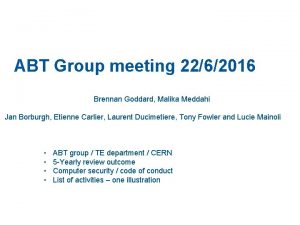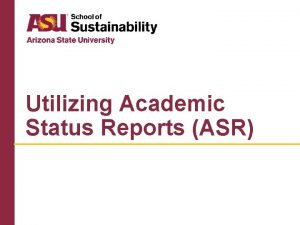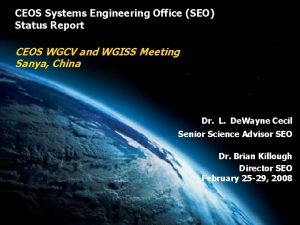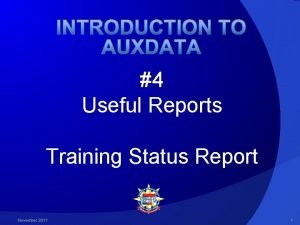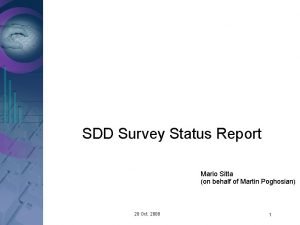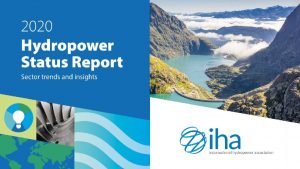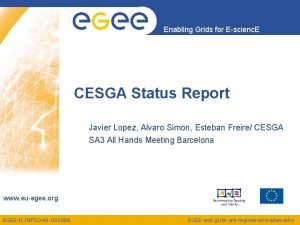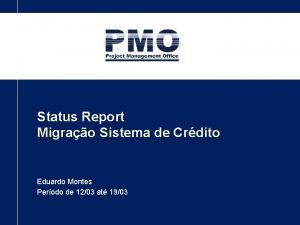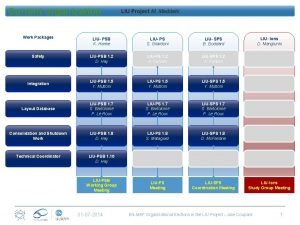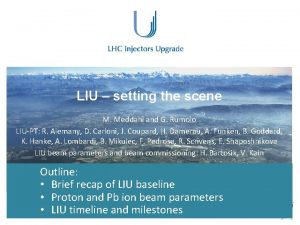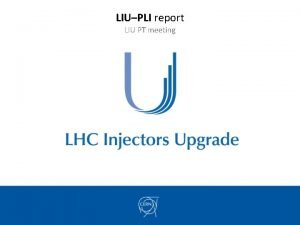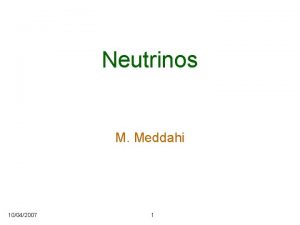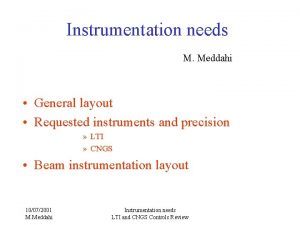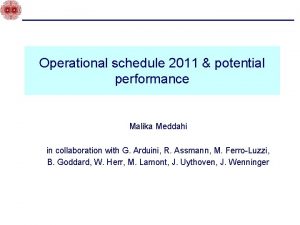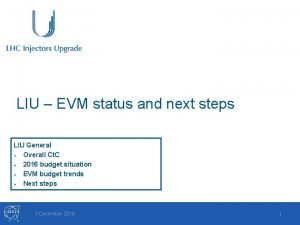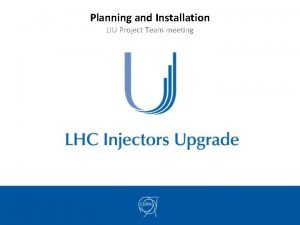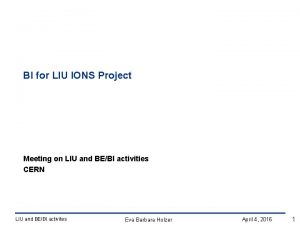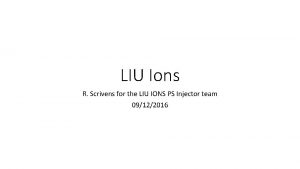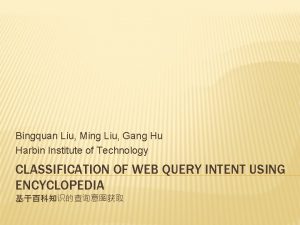Status report of the LIU project M Meddahi































- Slides: 31


Status report of the LIU project M. Meddahi, G. Rumolo With contributions from T. Argyropoulos, H. Bartosik, E. Carlier, J. Coupard, P. Cruikshank, P. Costa Pinto, H. Damerau, A. Findlay, A Funken, S. Gilardoni, B. Goddard, S. Hancock, K. Hanke, G. Iadarola, V. Kain, I. Kobzeva, A. Lasheen, K. Li, D. Manglunki, S. Mataguez, L. Mether, B. Mikulec, M. Paoluzzi, M. Schenk, E. Shaposhnikova, G. Sterbini, M. Taborelli, J. Varela, C. Zannini

Outline • Introduction • Goals and timelines of the LIU project • Outcome of Cost & Schedule Review in March 2015 • Protons: • LIU baseline as of 1/1/15 and expected Injector performance • Recent decisions on LIU pending items • Impact of proposed baseline changes • Ions: • LIU baseline performance vs. HL-LHC desired parameters • Injector limitation and ongoing activities • Conclusions

Outline • Introduction • Goals and timelines of the LIU project • Outcome of Cost & Schedule Review in March 2015 • Protons: • LIU baseline as of 1/1/15 and expected Injector performance • Recent decisions on LIU pending items • Impact of proposed baseline changes • Ions: • LIU baseline performance vs. HL-LHC desired parameters • Injector limitations and ongoing activities • Conclusions

Goals and means of the LIU project Increase intensity/brightness in the injectors to match HL-LHC requirements Þ Enable Linac 4/PSB/PS/SPS to accelerate and manipulate higher intensity beams (efficient production, space charge & electron cloud mitigation, impedance reduction, feedbacks, etc. ) Þ Upgrade the injectors of the ion chain (Linac 3, LEIR, PS, SPS) to produce beam parameters at the LHC injection that can meet the luminosity goal Increase injectors’ reliability and lifetime to cover HL-LHC run (until ~2035!) closely related to CONSolidation Þ Upgrade/replace ageing equipment (power supplies, magnets, RF, EL, CV…) Þ Improve radioprotection measures (shielding, ventilation…)

Timelines of LIU • LIU machine studies during Run 2 until LS 2 • Beam and simulation studies (e. g. space charge, e-cloud mitigation, instabilities) • Design, procurement and test of equipment (e. g. protection devices) • LIU installations and hardware work during (E)YETS’s, but mainly during LS 2 • Beam commissioning of LIU beams • Pb ion beams need to be ready by 2021 Pb-Pb ion run • Proton beams during Run 3 to be ready after LS 3 Run 2 LS 2 PHASE 1 with LIU studies, equipment design&test, installation + Run 4 Run 3 beam commissioning LS 4 Run 4 LS 3 PHASE 2 HL-LHC installation LS 5

LIU proton baseline as of 1/1/15 • PSB: • Double brightness with injection from Linac 4 • Acceleration to 2 Ge. V with upgraded main C 02+C 04 RF systems or replacement by Finemet cavity based RF system, and new main power supply • PS: • Injection at 2 Ge. V to mitigate space charge • Newly installed and upgraded longitudinal feedbacks (impedance reduction and against CBI) • SPS: • Power upgrade of the main 200 MHz RF system (plus double available 800 MHz voltage, and new LL RF system) • Electron cloud mitigation through a-C coating (baseline) or beam induced scrubbing • Removal of limits of beam dump and protection devices

LIU ion baseline as of 1/1/15 • Source & Linac 3: • Increase beam current by improving Low Energy Beam Transport (LEBT) • Linac 3 repetition rate: 5 Hz 10 Hz • LEIR: • Increase number of injections with increased beam cooling rate • Understand mitigate large beam losses at RF capture • PS: • Bunch splitting to produce 4 bunches with 100 ns bunch spacing • SPS: • Mitigate beam degradation at flat bottom • Upgrade SPS injection system with 100 ns rise time • Longitudinal slip-stacking 50 ns bunch spacing

Outcome of Cost & Schedule review 9 -11/3/15 • General remarks from reviewers • • Budgets are correctly assembled and adequate Schedule is generally well defined and realistic Significant ramp up of effort in the next 2 years requires close tracking of resources General concern about retiring expertise / expertise availability • Linac 4 recommendations • RFQ spare • PSB recommendations • Schedule the removal of old cables as soon as possible • Start installation of equipment for PSB upgrade as soon as possible to alleviate LS 2 schedule problem Presently mitigated by decision to postpone LS 2 by 6 months and extend it by 6 months to reduce schedule risk • PS recommendations • None • SPS recommendations • Items for cost saving (1) partial a. C coating (2) internal instead of external new beam dump • Include the shielding of SPS flanges in the LIU baseline (impedance reduction)

Outcome of Cost & Schedule review 9 -11/3/15 • IONS remarks & recommendations • The requirement for the ion upgrade of the injectors is not well understood. Luminosity goal and number of Pb-Pb runs on which this has to be delivered need to be defined. A common point and exact specifications could not be achieved during the meeting • The path to a higher Pb intensity is not clear due to an intensity limit in LEIR. Beam studies to understand this limit are required before the upgrade plan can be finalised • No clear mitigation plan has been identified if the intensity limit in LEIR cannot be resolved • A new 100 ns SPS injection kicker provides only marginal increase in luminosity A combined LIU/HL-LHC effort was launched to define the scope of the upgrade and translate it into desired sets of beam parameters at the SPS extraction

Outline • Introduction • Goals and timelines of the LIU project • Outcome of Cost & Schedule Review in March 2015 • Protons: • LIU baseline as of 1/1/15 and expected Injector performance • Recent decisions on LIU pending items • Impact of proposed baseline changes • Ions: • LIU baseline performance vs. HL-LHC desired parameters • Ongoing activities • Conclusions

LIU performance reach • Baseline as of 1/1/15 white area accessible • Linac 4 + 160 Me. V PSB injection • 2 Ge. V PS injection energy • 200 MHz SPS RF upgrade LIU baseline as of 1/1/15 HL-LHC request • Full SPS a. C coating • Upgrade of protection devices & SPS beam dump budget PS SPS losses 5% 10% blow-up 5% 10% … based on 2012 experience

Review on Finemet cavities • Finemet cavities for PSB • Scope: Upgrade the RF system by replacing existing C 02 and C 04 cavities by Finemet system to reach extraction energy of 2 Ge. V; possibility of replacing also C 16 under study r digital LLRF • MD results: All present means to manipulate the beam demonstrated to work fowith d e rs version for Finemet in operation on R 4, including impedance reduction S harmonics ndoon different ye e. P th flexibility for allocating ull r f • Committee comments: The Finemet systems will providenunprecedented o f ee ) and will become possible the voltage at most pertinent frequency and new beam as b manipulations 6 e h of C 1 n i l ase ment b s y a eplace g o l o r n e • Finemet cavity as longitudinal damper for PS h h c t e t g n t e cavity diwideband longitudinal damper to cure coupled-bunch instabilities • Scope: Use Finemet as u m l e c n n (i Fi beams B during with LHC-type acceleration and on flat-top to reach LIU performance S P e h t damping of coupled-bunch oscillations with Finemet cavity was demonstrated • MD results: First giving confidence in the concept and the defined specifications • Committee comments: Implementation shall proceed as soon as possible to get benefits before LS 2 and simplify setting-up after LS 2 full review on Indico

New SPS beam dump system in LSS 5 • Motivations • More robust dump block (TIDVG) design to cope with LIU beams and high power FT beams • Decouple dump from LSS 1 injection systems to reduce residual dose rate • Internal beam dump as new LIU baseline • Keep all robust features of existing dump system: simple and reliable • One absorber block for all beams from 14 to 450 Ge. V (no ‘forbidden energy zone’) • Specially designed containment/shielding volume significantly reduced activation and dose to personnel to improve ALARA during interventions on dump system and surrounding equipment • Concept fully validated including feasibility of installation during LS 2 (some points still under discussion: decommissioning of water cooled cables, new locations for instrumentation in LSS 5) IEFC presentation BA 5

SPS longitudinal impedance reduction • Longitudinal instability during ramp and flat top • Expected to limit the LIU performance even after RF upgrade • Lower threshold for multi-bunch compared to single bunch • Search for critical longitudinal impedance • Large contribution to total impedance from vacuum flanges • Shielding the vacuum flange transitions proposed solution SPS longitudinal impedance model single RF 12 bunches 9 x 1010 p/b QF-type flange shielded

SPS longitudinal impedance reduction 36 bunches measured instability threshold (2015) unstable 72 bunches measured instability threshold (2012) intensity needed for HL-LHC parameters 3 2 Impedance reduction gain: 1: Flanges QF-type + HOM 630 MHz 2: (1) + MKP 1 3: (2) + Flanges QD-type + other HOMs • Multi-bunch simulations (24 bunches) with double RF • Significant improvement of stability with shielded QF-type flanges together with damping of HOMs of 200 MHz cavity (which drive instability with slightly lower intensity threshold) • Beneficial effect from shielding QD-type flanges at much higher intensities • No simulations with feed-back and damper loops yet

SPS longitudinal impedance reduction 36 bunches measured instability threshold (2015) unstable 72 bunches measured instability threshold (2012) intensity needed for HL-LHC parameters 3 Impedance reduction gain: • 2 Proposed strategy to shield all QF-type flanges technical 1: Flanges–QF-type + HOM 630 MHz implementation and planning being finalized 2: (1)LIU-SPS + MKP coordination meeting on impedance reduction 1 3: (2) + Flanges QD-type + other HOMs • Expect to reach 2. 3· 1011 p/b at SPS flat top after impedance reduction campaign (including optimized HOM damping) • Multi-bunch simulations (24 bunches) with double RF • Significant improvement of stability with shielded QF-type flanges together with damping of HOMs of 200 MHz cavity (which drive instability with slightly lower intensity threshold) • Beneficial effect from shielding QD-type flanges at much higher intensities • No simulations with feed-back and damper loops yet

SPS scrubbing vs. coating review • Results from high intensity scrubbing runs 2015 • Horizontal coupled bunch instability can be stabilized with transverse damper, high Q’ + Octupoles • No sign of e-cloud induced blow-up along the bunch train • Impact on beam brightness (need to inject higher intensity to compensate for losses) intensity at end of injection plateau to reach 2. 0· 1011 p/b at flat top Extrapolation for 2· 1011 p/b at flat top • Expect 15% losses on injection plateau mostly due to e-cloud • Assume losses at beginning of ramp + scraping remain ~5% (LIU RF upgrade) • 20% total losses (~1. 5· 1013 p+/cycle) • Compared to SPS loss budget of 10%, the additional 10% losses effectively result in 10% reduced brightness

SPS scrubbing vs. coating review • Results from high intensity scrubbing runs 2015 • Horizontal coupled bunch instability can be stabilized with transverse damper, high Q’ + Octupoles • No sign of e-cloud induced blow-up along the bunch train • Impact on beam brightness (need to inject higher intensity to compensate for losses) • With experience to date, LIU and HL-LHC performance goals not guaranteed with scrubbing only • Status of a. C coating technology • In general the technology is well developed • Suppression of e-cloud effect demonstrated • In-situ coating for MBB is being developed • Remaining issues for industrialization (e. g. cleaning with oxygen plasma prior to coat) being addressed • Review recommendation • Make a. C coating of MMB dipoles the baseline until there is high confidence that scrubbing can establish LIU and HL-LHC performance goals full review on Indico

LIU-SPS proposed implementation strategy • EYETS 16/17: • Pilot (up to 1 arc) for coating QFs and QF SSS, in synergy with impedance reduction; • A few (4) MBB half-cells coated in-situ, to prototype the ‘final’ cleaning and coating technology; nt e m age • Replacement of some (10%) standard 156 mm drifts with coated chambers. • LS 2: an m e th by d e • Complete coating of remaining QFs and QF SSS, indsynergy ors with impedance reduction; n lly e and quality control; • Pilot (1 arc) MBB coating, to debug full-scale logistics u f een drifts with coated chambers. b s • Replacement of remaining 156 mm standard ha y g ate r t s • Run 3: This • Evaluation of whether these improvements, plus some improvements to the transverse damper and in combination with further scrubbing, are already enough to reach the performance target • LS 3: • If required, coating of remaining MBBs around the machine.

LIU-SPS Wideband Feedback system –US-LARP • The goal of this important USLARP supported LIU-SPS project is to gain experience and develop the necessary expertise on how to build a wideband transverse feedback system and to demonstrate that it can damp intra-bunch motion for a 25 ns bunch train. • Work is progressing as planned, in collaboration with John Fox’ team – see presentation on Wed. 28/10 at 11 h (W. Hofle / K. Li). • A review is set for September 2016 to examine the results from the prototype system, the demonstration of its effectiveness and functioning and the future potential for deployment in SPS and other accelerators. • A wideband feedback system is of great potential and the demonstration of its feasibility an important milestone on a path to a fully deployed system. When moving to the highest bunch intensities, new single bunch instabilities might be encountered and such a system is targeted to cure these. It is of high interest for the LHC, HL-LHC and as well for future accelerators.

Possible LIU performance reach SPS impedance reduction • Linac 4 + 160 Me. V PSB injection potential performance with new staged baseline pending careful analysis LIU baseline as of 1/1/15 • Baseline as of 1/1/15 • 2 Ge. V PS injection energy • 200 MHz SPS RF upgrade HL-LHC request • Full SPS a. C coating • Proposed new staged baseline Higher intensity reach pending detailed • analysis Linac 4 • Longitudinal instabilities in PS? • 2 Ge. V PS injection energy • Compatible with new SPS beam dump • system? 200 MHz SPS RF upgrade • Compatible with TEDs? • SPS impedance reduction (LS 2) • Compatible with new SPS TPSGs? • Partial SPS a. C coating (LS 2) + • Compatible with SPS injection dump? further scrubbing (Run 3) • Compatible with existing scraper system? +/ • Mitigation of MKE/MKP heating necessary? • Deploy remaining a. C coating • … (LS 3) if scrubbing not sufficient to reach target parameters

Implications of proposed staged baseline • Direct consequences of limited SPS coating during LS 2 • May need to inject (at least temporarily) very high intensities into the SPS in order to explore our desired beam parameters and accept larger losses • Need to study how to best cope with the losses reinvestigate need for SPS collimation system (ongoing) • Need to check if there are limitations for injected intensity and beam brightness in the SPS (e. g. from injection dump) • Are the pre-injectors ready to deliver the higher beam intensity? • Staged approach gives some optimism for matching the HL-LHC requirements before LS 3, with a path to the full solution to deploy in LS 3 if needed • Post-LS 2 beam performance will steer possible further interventions in the injectors in the next (E)YETs and LS 3 • Compatibility of MBB coating with LS 3 duration (12 months) and available resources to be checked • This implies that maybe the target parameters will be reached only after LS 3

Outline • Introduction • Goals and timelines of the LIU project • Outcome of Cost & Schedule Review in March 2015 • Protons: • LIU baseline as of 1/1/15 and expected Injector performance • Recent decisions on LIU pending items • Impact of proposed baseline changes • Ions: • LIU baseline performance vs. HL-LHC desired parameters • Injector limitations and ongoing activities • Conclusions

Parameter table @ SPS extraction • HL-LHC parameters based EDMS document 1525065 v. 0. 3 by J. Jowett • EDMS document 1533832 LIU beam parameters, in collaboration with J. Jowett (in preparation) → LIU could produce up to 2/3 of the HL-LHC desired luminosity goal, depending on the removal of the LEIR intensity limitation or staged SPS kicker upgrade

Main complex limitations - Linac 3 reduced maximum current - - LEIR maximum intensity due to losses at capture - - Larger number of injections in LEIR longer cycles longer SPS FB Bottleneck limiting maximum performances of the complex Losses/emittance degradation at SPS FB due to IBS-TSK-like effect - Intensity decreases along the batch imprinting pattern on LHC specific luminosity

Path of studies and actions • Linac 3 • About 20% improvement in transmission in the low energy part expected by installing new electrostatic lens (Einzel lens) and increasing aperture between source and first solenoid (YETS 2015 -16) • 10 Hz repetition rate operation to increase injection rate in LEIR (YETS 2015 -16), before LS 2 limited by CV, however extended testing possible • LEIR performance • Main bottleneck is loss at RF capture. Mechanism still being investigated (space charge? ) • Electron cooling with double current for faster cooling rate proved with Ar, further tests with Pb in 2016 • Full machine model with detailed optics including impedance and e-cooler not yet available, planned for 2016 development • SPS flat bottom beam degradation • Studies in 2012 -13 showed that losses along the batch seems to be more caused by IBS or Touscheklike effect mixed with direct space-charge and RF-noise • More studies in 2015 on Q 20, RF noise reduction, 2 nd harmonic to increase longitudinal acceptance, bunch length sensitivity • SPS slip stacking • No showstopper identified, implementation in LS 2 • Resources available in 2016 to develop LLRF, continue simulation work, study final bunch rotation • Tests foreseen prior to LS 2 to investigate beam lifetime without phase loop, define the momentum aperture, test and optimise the RF programs

Path of studies and actions • Linac 3 • About 20% improvement in transmission in the low energy part expected by installing new electrostatic lens (Einzel lens) and increasing aperture between source and first solenoid (YETS 2015 -16) • 10 Hz repetition rate operation to increase injection rate in LEIR (YETS 2015 -16), before LS 2 limited by CV, however extended testing possible y nsit e t in nt e r r cu • Main bottleneck is loss at RF capture. Mechanism still beingeinvestigated (space charge? ) h – t r tests y proved with Ar, further a • Electron cooling with double current for faster cooling rate with Pb in 2016 d e u y t s e to impedance and e-cooler • Full machine model with detailed optics including f th not yet available, planned for e o c la 2016 development end np i e y th am r b g • SPS flat bottom beamedegradation ing s pro IR d n a batch siv inthat • Studies in 2012 -13 tepseems to be more caused by IBS or Touschekstthe LElosses along r nshowed s e e t t x with tdirect like effect mixed n space-charge nd and n. RF-noise ex E o u i e a • the • More studies inli 2015 reduction, 2 nd harmonic to increase longitudinal acceptance, mit on Q 20, on. RFthnoise r o tf bunch length sensitivity ess u p r n rog tant i P • or • SPS slip stacking imp • LEIR performance • No showstopper identified, implementation in LS 2 • Resources available in 2016 to develop LLRF, continue simulation work, study final bunch rotation • Tests foreseen prior to LS 2 to investigate beam lifetime without phase loop, define the momentum aperture, test and optimise the RF programs

Outline • Introduction • Goals and timelines of the LIU project • Outcome of Cost & Schedule Review in March 2015 • Protons: • LIU baseline as of 1/1/15 and expected Injector performance • Recent decisions on LIU pending items • Impact of proposed baseline changes • Ions: • LIU baseline performance vs. HL-LHC desired parameters • Ongoing activities • Conclusions

Conclusions • LIU baseline program as of 1/1/15 • Protons: Can produce beams with the desired brightness, but intensity 15% lower • Ions: Clarify scope together with HL-LHC • New for protons • Finemet cavities endorsed as baseline for PSB (C 02, C 04 and also C 16) and PS • SPS impedance reduction to be included in baseline − Prospect of extending intensity reach close to HL-LHC request pending careful analysis of other potential limitations • New internal dump for SPS • Staged deployment of a. C coating for MBB chambers in synergy with impedance reduction − Maybe HL-LHC target parameters achieved only after LS 3 and possibly need to cope with increased losses in SPS during Run 3 • New for ions • Joint LIU/HL-LHC exercise to define set of desired beam parameters at LHC injection and upgrade scenarios Target up to 2/3 of desired integrated luminosity • Extensive program of studies in place to analyse present injector limitations

Thank you for your attention!
 Alex liu cecilia liu
Alex liu cecilia liu Líu líu lo lo ta ca hát say sưa
Líu líu lo lo ta ca hát say sưa Writing a status report
Writing a status report Malika meddahi cern
Malika meddahi cern Malika meddahi
Malika meddahi Academic status report
Academic status report Work status report from doctor
Work status report from doctor Kaiser code green
Kaiser code green Vendor status report
Vendor status report Convercent report status
Convercent report status Seo status report
Seo status report Triennial status report
Triennial status report Training status report
Training status report What is a rag report
What is a rag report Annual status of education report
Annual status of education report Vertical mario
Vertical mario 2020 hydropower status report
2020 hydropower status report Status report
Status report Status report executivo
Status report executivo Hình ảnh bộ gõ cơ thể búng tay
Hình ảnh bộ gõ cơ thể búng tay Ng-html
Ng-html Bổ thể
Bổ thể Tỉ lệ cơ thể trẻ em
Tỉ lệ cơ thể trẻ em Voi kéo gỗ như thế nào
Voi kéo gỗ như thế nào Glasgow thang điểm
Glasgow thang điểm Chúa yêu trần thế
Chúa yêu trần thế Các môn thể thao bắt đầu bằng tiếng đua
Các môn thể thao bắt đầu bằng tiếng đua Thế nào là hệ số cao nhất
Thế nào là hệ số cao nhất Các châu lục và đại dương trên thế giới
Các châu lục và đại dương trên thế giới Công thức tính độ biến thiên đông lượng
Công thức tính độ biến thiên đông lượng Trời xanh đây là của chúng ta thể thơ
Trời xanh đây là của chúng ta thể thơ Cách giải mật thư tọa độ
Cách giải mật thư tọa độ




